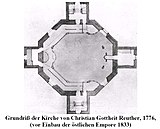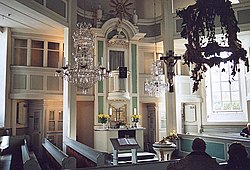Seiffen Church
The Seiffen Church , or as it is officially called, Bergkirche Seiffen , is the Evangelical Lutheran church in the Seiffen community in the Erzgebirge district in Saxony . It is the symbol of the place and a popular motif of the Erzgebirge folk art .
Building history
The Seiffen church stands on a mountain ledge in the center of the village. According to tradition, a small chapel stood here for the first time around 1570, which was demolished in the spring of 1776 because it was dilapidated. According to a plan by Christian Gotthelf Reuther (1742–1795), who lived in Kreischa near Dresden and who took the Dresden Frauenkirche as a model, the new church was built from 1776 to 1779 with an octagon floor plan . The new mountain church was consecrated on November 7th, 1779 by Superintendent Christoph Gottlob Grundig from Freiberg. Above the entrance of the church, which is considered a testimony to the piety of the miners, there is an inscription: “To the glory of God and to the salvation of men”. On the church's weather vane there is a cast bronze miner figure, which refers to the tin mining industry, which Seiffen owes its existence to.
Interior
The pulpit altar typical of Saxon baroque churches and the two confessional chambers to the left and right of the altar date from the time it was built . The consolation cross on the column next to the altar and the glass chandelier from the Heidelbach glassworks above the baptismal stand (made in 1670) were taken over from the previous church. The other three glass chandeliers date from 1784, 1815 and 1884 and were made in Bohemian glassworks. In 1798 the west gallery was extended for the first organ. The organ is equipped with a Zimbelstern . In 1833 the number of seats was increased to around 500 today by installing two boxes and the surrounding gallery in the chancel. In 1873 the Poppe brothers from Roda built today's organ (2 manuals, 16 stops ). The year numbers under the organ gallery give a short form of the building history of the church. An old coffin cross hangs above the main entrance to the church. With the inscription "Bergknappschaft Seiffen 1688" on the reverse, it refers to the Seiffen miners' association, first mentioned in 1686. Miners and angels with lights in hand at the main entrance of the church remind us that Seiffen lives from the joy of Christmas. The two arms in the sanctuary recall the family of Schoenberg on Schloss Purschenstein that seemed long as patrons of the church, and to the existing to 1849 seiffen Mining Authority.
Peal
The ringing consists of three chilled cast iron bells. The belfry consists of a steel structure. Below is a data overview of the bell:
| No. | Casting date | Caster | material | diameter | Weight | Chime |
|---|---|---|---|---|---|---|
| 1 | 1919 | Bell foundry Bochumer Verein | Chilled iron | 915 mm | 340 kg | H' |
| 2 | 1919 | Bell foundry Bochumer Verein | Chilled iron | 800 mm | 230 kg | d ″ |
| 3 | 1919 | Bell foundry Bochumer Verein | Chilled iron | 675 mm | 145 kg | f ″ |
meaning
The church is undoubtedly the most common wooden church in the world. It is called the church of lights because until 1959 it was lit almost exclusively by candles. It is considered a popular wedding church. In 2009 it was visited by visitors from 27 countries.
literature
- Michael Harzer / Günther Zielke: A booklet on the Seiffen mountain church for children and adults. Seiffen 2007.
- Barbara Bechter: Bergkirche Seiffen, Deutscher Kunstverlag 2010.
- Acts on the construction of the church 1772–1779, Seiffen parish.
- Church guest books, kept in the Seiffen parish office.
- Richard Steche : Seiffen. In: Descriptive representation of the older architectural and art monuments of the Kingdom of Saxony. 3. Issue: Amtshauptmannschaft Freiberg . CC Meinhold, Dresden 1884, p. 121.
- Rainer Thümmel: Bells in Saxony. Sound between heaven and earth. Edited by the Evangelical Regional Church Office of Saxony . With a foreword by Jochen Bohl and photographs by Klaus-Peter Meißner. 2nd, updated and supplemented edition. Evangelische Verlagsanstalt, Leipzig 2015, ISBN 978-3-374-02871-9 , p. 358.
Web links
- Bergkirche Seiffen Official website
- The Seiffener Bergkirche - information on the building history and furnishings at mueller.com
Individual evidence
- ↑ The building history of the church (PDF) Seiffen Church. Retrieved April 21, 2010.
- ^ Rainer Thümmel : Bells in Saxony: sound between heaven and earth . Evangelische Verlagsanstalt, Leipzig 2011, ISBN 978-3-374-02871-9 , pp. 358 .
- ↑ Seiffen Baroque Church . Seiffen municipal administration. 2009. Archived from the original on November 11, 2010. Info: The archive link was automatically inserted and not yet checked. Please check the original and archive link according to the instructions and then remove this notice. Retrieved April 21, 2010.
Coordinates: 50 ° 38 ′ 50 ″ N , 13 ° 27 ′ 6 ″ E





